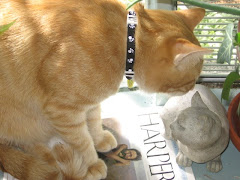

Condiments of the Season
Text and Photos by : Füsun Atalay ~ Copyright © 2005
Pickling is defined by most culinary sources as one of the oldest methods of preserving vegetables, as well as some kinds of fish, in salt and/or vinegar to provide a bacteria-free environment that prevents spoiling.
Yet to many of us who love colourful jams and savoury pickles, the art of preserving food seems like a highly demanding culinary alchemy.
I fondly remember my mother and grandmother turning fruits picked at their perfection, or seasonal vegetables, into shimmering preserves and mouth-watering pickles and chutneys.
Although I have not been diligent to follow in their footsteps, I’ve come to realize over the years that preserving or pickling doesn’t have to be intimidating if one follows a few steps and pays attention to some important points.
With that in mind, I recently started taking baby steps towards making my own pickles and preserves.
Yet to many of us who love colourful jams and savoury pickles, the art of preserving food seems like a highly demanding culinary alchemy.
I fondly remember my mother and grandmother turning fruits picked at their perfection, or seasonal vegetables, into shimmering preserves and mouth-watering pickles and chutneys.
Although I have not been diligent to follow in their footsteps, I’ve come to realize over the years that preserving or pickling doesn’t have to be intimidating if one follows a few steps and pays attention to some important points.
With that in mind, I recently started taking baby steps towards making my own pickles and preserves.
Once I decided to try my hand at pickling, I thought I should keep a journal to record what worked and what did not, in order to chart a few rules for success.
The most important rule for me, (needless to say, after a few trials and errors) is to follow a recipe exactly, without altering the types and amounts of salt or vinegar.
Then, just as important as the first rule, is the next step, which is starting with crisp, blemish-free produce. To ensure freshness, use the vegetables within 24 hours after washing them under lots of cold, running water.
There is a difference between pickling salt and table salt — the latter contains iodine which can darken pickles. Anti-caking agents in table salt can cause cloudiness in your brine. Therefore, do not compromise and use one for the other.
Use only soft water because it has low levels of minerals and chlorine. Hard water is high in mineral levels and therefore can lower brine acidity, jeopardizing food safety.
That explains why Mom used to boil water for 15 minutes, then allowed it to stand covered until next day. She would remove any surface scum that formed and ladled the water from the pot without agitating the sediment settled at the bottom. It was just something that one did when one made pickles — no questions.
But I feel knowing the reason for doing things helps to understand the chemistry of ingredients. The boiling process kills some of the minerals, and consequently softens hard water.
My mother used commercial white vinegar with at least five per cent acidity, or "pickling vinegar" (7 per cent acidity), over malt or cider vinegars which had their use for salads only. She said salad vinegars darkened light-coloured vegetables such as cauliflower or celery.
When it comes to spices, it’s best to use fresh, whole, crushed or ground spices, because powdered spices can turn the pickling liquid dark and murky. Pickling spices are available at the supermarket, but we always made our own by combining black peppercorns, fennel seeds, celery seeds, dill seeds, bay leaves, chili peppers, yellow mustard seeds, cinnamon sticks, whole cloves and coriander seeds in a small bag made of cheesecloth.
Finally, use heat-proof glass, stainless steel or hard-anodized aluminum pots and pans. We preserved our pickles in glass or ceramic bowls until they were ready to serve.
Cooked Antepasto
An old family recipe, it is as easy as it is delicious. Start with the freshest vegetables you can find.
3/4 cup vegetable oil
1 cup chopped celery
1 cup sliced carrots
250 g fresh mushrooms, quartered
1 large green pepper, chunked
1 large red pepper, chunked
1/2 cauliflower head broken into small florets
375 ml jar pickled onions, drained
1 cup white wine
1 cup vinegar
1 small can tomato paste
1/4 cup brown sugar, packed
1 bay leaf
4 cloves garlic, minced
2 - 170-g cans white chunk tuna, drained
1/2 cup dill pickles, sliced and drained
3/4 cup pimento stuffed olives, drained
Heat oil in pan and saute celery, carrots mushrooms, peppers, pickled onions and cauliflower. Cover and cook with lid on for 5 minutes.
Add the white wine vinegar, tomato paste, bay leaf, garlic and brown sugar. Cook uncovered for 10 minutes to allow some liquid to evaporate.
Stir in tuna, dill pickles and olives. Cover and cook 10 minutes more. Remove bay leaf, cool. Spoon into sterilized jars, cover and store in the refrigerator.
Pickled Crunchy Vegetables
But I feel knowing the reason for doing things helps to understand the chemistry of ingredients. The boiling process kills some of the minerals, and consequently softens hard water.
My mother used commercial white vinegar with at least five per cent acidity, or "pickling vinegar" (7 per cent acidity), over malt or cider vinegars which had their use for salads only. She said salad vinegars darkened light-coloured vegetables such as cauliflower or celery.
When it comes to spices, it’s best to use fresh, whole, crushed or ground spices, because powdered spices can turn the pickling liquid dark and murky. Pickling spices are available at the supermarket, but we always made our own by combining black peppercorns, fennel seeds, celery seeds, dill seeds, bay leaves, chili peppers, yellow mustard seeds, cinnamon sticks, whole cloves and coriander seeds in a small bag made of cheesecloth.
Finally, use heat-proof glass, stainless steel or hard-anodized aluminum pots and pans. We preserved our pickles in glass or ceramic bowls until they were ready to serve.
Cooked Antepasto
An old family recipe, it is as easy as it is delicious. Start with the freshest vegetables you can find.
3/4 cup vegetable oil
1 cup chopped celery
1 cup sliced carrots
250 g fresh mushrooms, quartered
1 large green pepper, chunked
1 large red pepper, chunked
1/2 cauliflower head broken into small florets
375 ml jar pickled onions, drained
1 cup white wine
1 cup vinegar
1 small can tomato paste
1/4 cup brown sugar, packed
1 bay leaf
4 cloves garlic, minced
2 - 170-g cans white chunk tuna, drained
1/2 cup dill pickles, sliced and drained
3/4 cup pimento stuffed olives, drained
Heat oil in pan and saute celery, carrots mushrooms, peppers, pickled onions and cauliflower. Cover and cook with lid on for 5 minutes.
Add the white wine vinegar, tomato paste, bay leaf, garlic and brown sugar. Cook uncovered for 10 minutes to allow some liquid to evaporate.
Stir in tuna, dill pickles and olives. Cover and cook 10 minutes more. Remove bay leaf, cool. Spoon into sterilized jars, cover and store in the refrigerator.
Pickled Crunchy Vegetables
All or any combination of:
small cauliflower broken into florets
carrots, sliced diagonally
celery stalks sliced diagonally into 3 cm pieces
celery leaves
fresh green beans
snow peas
large red pepper cut into 2 cm strips
Along with
garlic cloves, peeled
Kosher salt
white vinegar
pickling spices
water
Boil 12 cups of water and allow to cool to lukewarm. Wash and prepare vegetables. Place them tightly into prepared jars. You can use Mason jars or sterilized old pickle jars, as I do.
For each cup of water add:
1 Tbsp. Kosher salt
4 Tbsp. white vinegar
1 tsp. pickling spice
Stir and pour into vegetable packed jars.
Cover jars with plastic wrap. Place covers on and leave upside down at room temperature overnight. Next day, place jars in the refrigerator and keep refrigerated for 10 days before serving. Store in the fridge.
Pickled Salmon Chili
This appetizer or first-course recipe comes from my dear friend, Phyllis Levitt
5 lb. Atlantic salmon, cut into 4-oz. portions
4 cups boiled water
1 tsp. salt
1 tsp. pepper corns
2 cups white vinegar
1 cup sugar
2 Tbsp. pickling spices
5 bay leaves
1 10-oz. bottle Heinz chili sauce
1 Spanish onion, sliced thickly
In a large pot, place hot water, vinegar, salt, pepper corns, bay leaves, oil, spices and chili sauce and bring to a boil. Lower heat, gently place a few portions of salmon. Steam portions, turning once until they are opaque but still raw inside.
Remove salmon portions carefully and place in a large glass or ceramic dish to cool. Add sliced onions between layers of salmon and on the top. Pour sauce over the layers, cover with plastic wrap and refrigerate 3-5 days before serving, basting once a day. When ready to serve, strain sauce to remove most of the spices.
small cauliflower broken into florets
carrots, sliced diagonally
celery stalks sliced diagonally into 3 cm pieces
celery leaves
fresh green beans
snow peas
large red pepper cut into 2 cm strips
Along with
garlic cloves, peeled
Kosher salt
white vinegar
pickling spices
water
Boil 12 cups of water and allow to cool to lukewarm. Wash and prepare vegetables. Place them tightly into prepared jars. You can use Mason jars or sterilized old pickle jars, as I do.
For each cup of water add:
1 Tbsp. Kosher salt
4 Tbsp. white vinegar
1 tsp. pickling spice
Stir and pour into vegetable packed jars.
Cover jars with plastic wrap. Place covers on and leave upside down at room temperature overnight. Next day, place jars in the refrigerator and keep refrigerated for 10 days before serving. Store in the fridge.
Pickled Salmon Chili
This appetizer or first-course recipe comes from my dear friend, Phyllis Levitt
5 lb. Atlantic salmon, cut into 4-oz. portions
4 cups boiled water
1 tsp. salt
1 tsp. pepper corns
2 cups white vinegar
1 cup sugar
2 Tbsp. pickling spices
5 bay leaves
1 10-oz. bottle Heinz chili sauce
1 Spanish onion, sliced thickly
In a large pot, place hot water, vinegar, salt, pepper corns, bay leaves, oil, spices and chili sauce and bring to a boil. Lower heat, gently place a few portions of salmon. Steam portions, turning once until they are opaque but still raw inside.
Remove salmon portions carefully and place in a large glass or ceramic dish to cool. Add sliced onions between layers of salmon and on the top. Pour sauce over the layers, cover with plastic wrap and refrigerate 3-5 days before serving, basting once a day. When ready to serve, strain sauce to remove most of the spices.
This will keep a long time in the refrigerator — if it lasts.
Copyrighted Material ~ Copyright © 2005 All Rights belong to Füsun Atalay







































